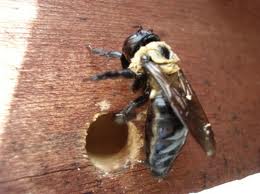Carpenter bees belong to the genus known as Xylocopa, which is comprised of around 500 carpenter bee species that are distributed all over the world. Carpenter bees can be found in the southern and eastern states of the US, and they are the largest bees in the country in terms of body size. These bees are not known for dealing out painful stings, but they are notable for damaging trees and structural wood within homes. Unfortunately, the carpenter bee species that resides in Massachusetts is the most damaging carpenter bee species that exists in the US. This species is commonly known as the eastern carpenter bee, and they are often spotted buzzing around homes during the spring and summer seasons.
The eastern carpenter bee’s large body size and distinct coloring leads many people to mistakenly identify these bees as bumblebees. But unlike the bumblebee’s yellow and furry abdomen, carpenter bees have a smooth and entirely black abdomen. These bees are often spotted around a house’s eaves, beneath decks and patios, and other areas where structural wood is out in the open. Unlike termites, carpenter bees do not consume wood; instead, these bees excavate wood for nesting and reproductive purposes. This excavating activity weakens structural wood, which can make floorboards, decks and patios vulnerable to collapse.
In addition to damaging structural wood, carpenter bees can also become a nuisance to Massachusetts residents during the warmer months. Although male carpenter bees cannot sting, they are known for their habit of darting toward people who make sudden movements. This seemingly aggressive behavior can cause some people to panic in fear of being stung or swarmed by a group of bees. Female carpenter bees can sting humans, but such incidents are quite rare, as it takes alot to provoke a female carpenter bee into stinging a human.
Preventing carpenter bee infestations within a home or building is very difficult, if not impossible. This is because carpenter bees do not consume insecticide treatments on structural wood. Also, basically all wooded areas of a home are vulnerable to carpenter bee attacks, making it impractical to apply insecticides to all of these areas. Carpenter bee infestations must be addressed by a licensed professional.
Have you ever been frightened by a bee that had been hovering around your head for an unusual length of time?

